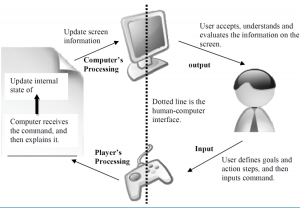- Select One Example to Outline the Key Concepts of Human-Computer Interaction. Reflect Upon the Role of the “Human”, the “Computer” and the “Interaction”.
&
- Discuss the Relationship Between Games Design and Human-Computer Interaction.
1
“Human-Computer Interaction (HCI) is an area of research and practice” (Carroll, n.d.). HCI emerged in the 1980s, initially as a specialised area of Computer Science, embracing cognitive science and human factors engineering. HCI, has rapidly expanded since then, incorporating diverse approaches to further the research.
The key concept of HCI is to understand the factors that determine how people use technology, this could be the ease of learning, remembering how to use it, effective and efficient use, safe use and enjoyable use. A lot of everyday systems and products seem to be designed with little regard to usability.
Computing moving off of the desktop to be everywhere with ease, is one example. Computers are everywhere, phones, cars, meeting rooms, hotels and classrooms. The focus of HCI moved from the desktop and will continue to move. HCI is a technology area, and it is ineluctably driven to frontiers of technology and application possibility. This movement of HCI from desktop is a large-scale example of a pattern of development that is replicated through HCI at many levels of analysis. To be more specific, the adaptation of the unlock function on a mobile phone, initially beginning with the simultaneous press of ‘*+Enter’ on the Nokia 3310 to the now simple finger print scanner or facial recognition on the Samsung Galaxy S8.
The User
- This can be an arguable term as it could mean the individual or group working together. An appreciation of the way people’s sensory systems relay information, is vital. Also, different users form different conceptions of their interactions and have different ways of learning and keeping knowledge
The Computer
- This is referring to any technology ranging from computer systems to home computers. For example, if discussing web design, then the website itself would be referred to as “the computer”. Devices such as mobile phones can also be considered “computers”
Interaction
- There are clear differences between humans and machines. HCI, is the bridge between the two to ensure both work together fluidly. In order to achieve a usable system, you need to apply what you know about Humans and Computers, and consult with likely users throughout design processes.
2
At present the design area of HCI, within game holds a close connection: “Usability” is an important research of HCI within games, due to user feedback on gameplay, which is actually based on the usability of game software. At this point, gameplay is also called playability.
According to the theory of human-computer interaction described by Don Norman, the principle of “Simple, natural, friendly and consistent” should be reflected in every aspect of the progress in the game design (Norman, 1988). Flexibly applying these principles to the design of the interactive game not only establish good communication between player and computer, but also achieve the entertainment value of games.
References
Bomb, G. (n.d.). Retrieved from https://www.giantbomb.com/io-interactive/3010-3562/
Carroll, J. M. (n.d.). The Encyclopedia of Human-Computer Interaction, 2nd Ed. Retrieved from Interaction Design Foundation: https://www.interaction-design.org/literature/book/the-encyclopedia-of-human-computer-interaction-2nd-ed/human-computer-interaction-brief-intro
CBSNews. (2013, February 9). Preview: The Last of US. Retrieved from CBS News: https://www.cbsnews.com/news/preview-the-last-of-us/
D, B. (2017, June 20). Hitman Episode 1: ICA FAcility Free Download Available on PS4, PC, Xbox One. Retrieved from One Angry Gamer: https://www.oneangrygamer.net/2017/06/hitman-episode-1-ica-facility-free-download-available-on-ps4-pc-xbox-one/33425/
Ding, Y. Z. (2003). The Designing and Development of Game. People’s Traffic Press.
FrictionalGames. (2017). In the Games of Madness. Retrieved from http://frictionalgames.blogspot.co.uk/
Indie Game The Movie (2012). [Motion Picture]. Retrieved from https://vimeo.com/ondemand/indiegamethemovie/25268139
Lebowitz, J. (2011). Interactive Storytelling for Video Games.
McMullin, K. (2014, April 24). Passive vs. Active Participants. Retrieved from Collegewise: http://wiselikeus.com/collegewise/2014/04/passive-vs-active-participants.html
Norman, D. (1988). The Design of Everyday Things.
Playstation. (n.d.). The Last of Us Remastered. Retrieved from Playstation: https://www.playstation.com/en-gb/games/the-last-of-us-remastered-ps4/
Smithsonian. (n.d.). Apple 2 Personal Computer. Retrieved from National Museum of American History: http://americanhistory.si.edu/collections/search/object/nmah_334638


